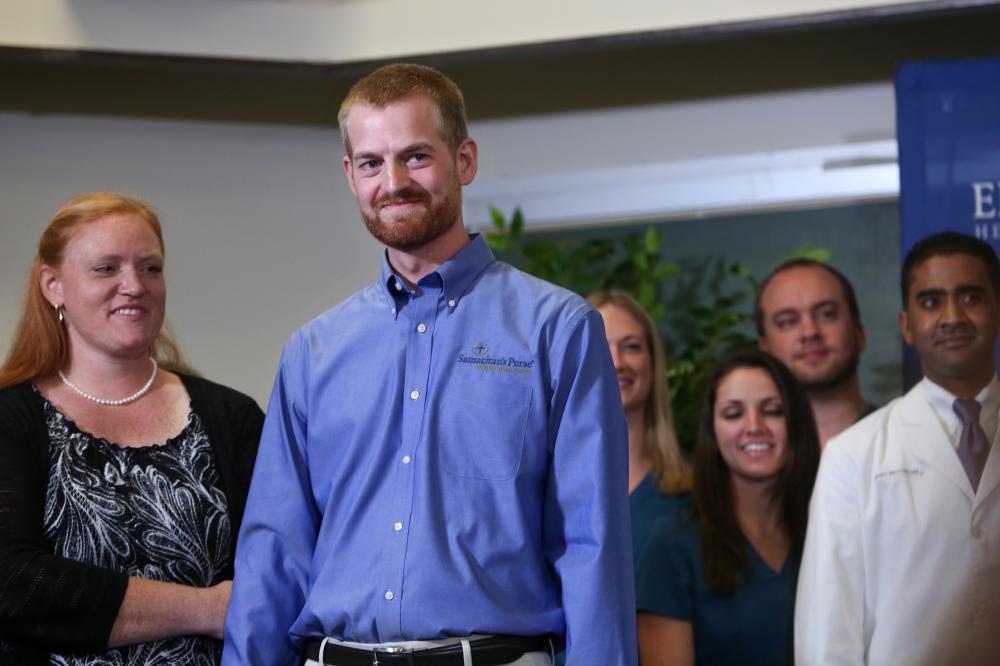It was a public health first. Doctors discharged two Americans from a hospital in Atlanta after treating them for Ebola.
Dr. Kent Brantly and Nancy Writebol caught the virus in July while working with Christian aid groups at a clinic in Monrovia, Liberia. The two were flown to Emory University Hospital in early August.
Brantly and Writebol went through “a rigorous course of treatment and thorough testing for treatment,” before they were release, said Emory’s Dr. Bruce Ribner, at a press conference Thursday. He is confident that their release posed no threat to the public, Ribner added.
But still, the news of Brantly’s and Writebol’s release generated a flurry of questions from our readers — and our team members. To answers some of the most frequently asked ones, we reached out to Dr. Barbara Knust, an epidemiologist at the Centers of Disease Control and Prevention.
She responded through a CDC spokesperson via email. We’ve edited her responses for clarity and space.
Can a survivor pass the Ebola virus on to someone else through, for example, a hug or a kiss?
Ebola is spread only by people exhibiting symptoms and through direct contact with bodily fluids. Once a person recovers from Ebola virus disease, he or she is no longer shedding virus, and thus is not contagious.
In past Ebola outbreaks, follow-up studies of patients who have recovered from Ebola and their contacts found no evidence that the Ebola virus was spread from a recovered patient to their close contacts.
We’ve read that the virus still lingers in semen and breast milk after recovery. Is that true?
The World Health Organization states that the Ebola virus has been found in male semen up to seven weeks after recovery. They also cite a specific instance when the Ebola virus was found in the semen of a man 61 days after recovery.
Therefore, male survivors of Ebola are advised to avoid having sex for three months or to use condoms. (In an earlier interview, Knust also said that women are instructed to wean any children who have been breast-feeding.)
Semen and breast milk are not the primary means by which Ebola is transmitted. The virus is primarily transmitted via blood, sweat, feces and vomit.
As you may have heard today from Emory officials and Dr. Brantly, neither Brantly nor Writebol are completely sure how or where they contracted the virus. But each knows they either treated Ebola patients or were in close contact with those who treated Ebola patients. In either case, we just don’t know what bodily fluid may have been the vessel of transmission.
Can there be long-term damage to a person’s organs after recovering from Ebola?
There could be, though CDC isn’t aware of any. Ebola is a severe disease, and recovery can take a long time. Long-term damage would depend on the clinical course the disease took.
Does a survivor suffer any irreversible damage?
We don’t have data on this.
In a previous interview, Dr. Darin Portnoy, of Doctors Without Borders, said renal, kidney, liver or lung function can take some time to recover in some cases. If the patient goes into shock, it can also damage the heart muscle, which may not ever recover. A shock-like state can also decrease blood flow to the brain and cause some irreversible damage. Each case is different, Portnoy stressed.
Would it be safe for Brantly to go back to Africa?
That would be a question for the medical team that treated him. Whether Dr. Brantly returned to Africa would be a decision made by him and his employer.
Is there any risk of relapse?
This is a viral disease, and testing conducted by the CDC indicated the virus is no longer inside Dr. Kent Brantly or Nancy Writebol. There has been no risk of relapse reported.
Is Brantly now immune to all strains and species of Ebola, or just the strain that he caught?
Most likely, his immune system developed antibodies against the Zaire species of Ebola virus that infected his body. Certainly, he has some immunity against that type of Ebola. But it’s uncertain how long that immunity will last and whether he now has immunity against the other known Ebola species.
9(MDA3MTA1NDEyMDEyOTkyNTU3NzQ2ZGYwZg004))
